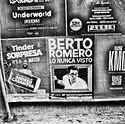banksy
Member
- Joined
- Jul 4, 2009
- Messages
- 21
Thought I'd have a go at making some ziatype prints (in palladium), but have hit a hurdle early on. In trying to determine my baseline printing time I'm finding it impossible to get steps 1 and 2 to merge on my Stouffer (31 step) step wedge. Increased exposure time beyond a certain point (5 minutes) produces virtually no change in steps 1 and 2.
I'm guessing this is down to the self-masking effect of the process?
If so, is there a way to accurately determine your baseline printing time for this process - i.e. the time at which increased exposure yields little or no gain in density in step 1 - or is it simply a case of making a series of test strips by printing the step wedge for different lengths of time and making visual comparisons?
Thanks.
I'm guessing this is down to the self-masking effect of the process?
If so, is there a way to accurately determine your baseline printing time for this process - i.e. the time at which increased exposure yields little or no gain in density in step 1 - or is it simply a case of making a series of test strips by printing the step wedge for different lengths of time and making visual comparisons?
Thanks.





